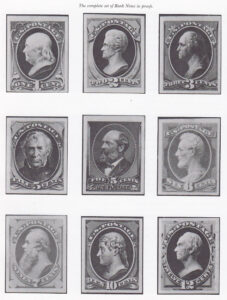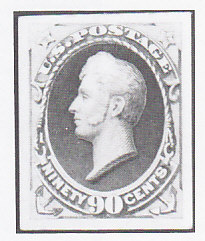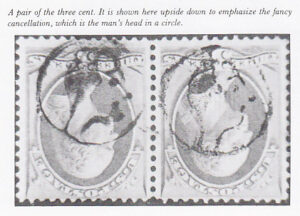Beginning with 1870 and the issues that philatelist term the Bank Notes, United States stamps entered a new philatelic period. These stamps are called the Bank Notes because they were printed over they twenty-year span by three successive bank note-printing companies, the National, the Continental, and the American Bank Note companies.
The different printings of these stamps by the three companies are treated by philatelists as different stamps. For years, some collectors have had difficulty identifying among the printings, but in recent years the trouble has been alleviated. Our knowledge of these stamps has increased, but the reason that the stamps are easier to distinguish is primarily because the differences between the stamps are now better explained. For years philatelic writers wrote only for a specialized audience; only in the last twenty years have easier explanations in plain English been available. The lower values of the stamps can be distinguished with little experience; the higher values are more difficult.
There are four different sets of Bank Notes. The first set is #134-144, printed by the National Bank Note Company on grilled paper. Next are #145-155, printed by the National Bank Note Company on ungrilled paper.
It should be remembered that the grills on the grilled Bank Notes were placed in a perfunctory manner. The government maintained its order that all supplied stamps were to be grilled, but beyond that they rarely inspected the stamps very carefully. They were beginning to tire of the idea of grilling stamps, and within a few months the National Bank Note Company was permitted to supply stamps with no grill at all. Further, the grills on the stamps that they did supply grilled were rarely fully impressed, and often had the appearance of several sheets having been placed in the grilling machine at once.
After the ungrilled National Bank Note Company’s printing of the issue called the Bank Notes come #156-166, printed by the Continental Bank Note Company, who out bid the National for the new contract that was awarded in 1873. the Continental added small distinguishing marks to the stamp plates so that they could tell their own printed stamps from those printed y National. These distinguishing marks are called by philatelists “secret marks” and the general stamp catalogues illustrate them quite well. The secret marks do not exist on the high values of the set, which must be told by shade alone.
Finally, there is the American Bank Note printing of #182-191, printed in 1879 on the same plates but on soft porous paper. Soft porous paper is extremely distinctive. When held to the light, the paper shows a marked weave; when bent, it bends very easily, with none of the spring of the earlier papers. But the most distinctive test is to place a stamp face down in a watermark tray filled with watermark fluid. There, the distinctive weave will invariably proclaim its status. The American Bank Not Company printed stamps from these plates for years, and late in the 1880s retouched some of the designs. These are given special catalogue numbers and the subtle differences are well illustrated in the catalogue.



Since the Bank Notes were the postage stamps for a nation for so long a period, hundreds of printings were necessary. Of the three-cent stamp, 6.5 billion stamps were printed and sold over a twenty-year period. Collectors avidly specialize in these stamps. Indeed, with the exception of the grilled Bank Notes and the higher values above the twenty-four cent, used Bank Notes are quite common and well within the price range of most collectors.



Bank Notes can be collected in basically two ways. First, a collector can attempt to own one of each of the stamps printed by each of the printing companies. This is how most collectors attempt it, and this is how the stamps are arranged in most catalogues and albums. The second method is gaining more and more favor. It begins with finding one of the low-value stamps that you especially like and creating a specialized collection. For about $100, a collector can purchase well over 2,000 of the three-cent Bank Notes. Each stamp is a piece of history in its own shade and with its own distinct cancellation specializing like this is usually an adjunct to a general United States collection and can offer satisfactions all its own.
The higher-value Bank Notes have great interest because of their rarity and the problems in finding them in excellent condition. The twenty-four cent is an exceedingly difficult stamp. The color has faded badly to such a dull shade of light lilac (listed as purple in the catalogue but not what people would usually call purple) that often the details are difficult to see. The twenty-four cent National grill is one of America’s rarest stamps; only 2,000 were printed and probably but a handful remain. If it were a face different variety, rather than a variety with a grill (always less popular with collectors), it would no doubt sell for five or ten times its current $10,000 price tag. Te twenty-four cent is known in only two ways—grilled and ungrilled, both printed by the National Bank Note Company. It is a matter of record that the Continental Bank Note Company printed and issued twenty-four cent stamps in 1873, but these stamps are indistinguishable from the National printings.
For years these twenty-four-cent Continentals were listed as Scott #165, at about the same price as #153; but because the two varieties are identical, wisdom overcame tradition, finally, and the listing was taken out. There is an old story about a stamp dealer, back in the days when these two identical ungrilled twenty-four-cent stamps were given separate catalogue listings, who kept all his twenty-four-cent Bank Notes in his stock book, with no number on them, of course. When asked for one or the other, he would pull two examples out of the book, and begin discoursing on their differences and why one was the variety for which the collector was looking. There was far less substance than salesmanship in all of this, though, because both stamps sold for the same price, advantage was taken only of the truth.
